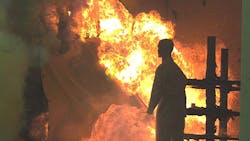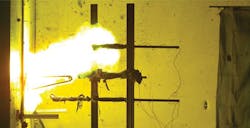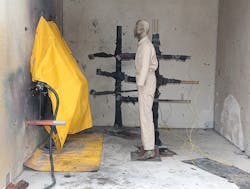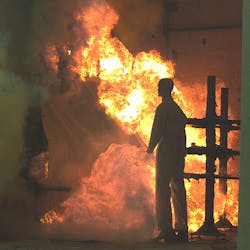Testing for Safety
Commonwealth Edison (ComEd) conducted a survey of the utility industry on how to determine energy created during arc flash events. The limited information available focused on selecting arc-rated clothing rather than determining the parameters for calculating the incident heat energy. ComEd’s research also revealed the industry was not aligned on the best methodology to use when estimating the incident heat energy.
In an effort to find a better way to protect its employees, ComEd contacted the Kinectrics High Current Testing Lab in Toronto, Canada, and arranged to conduct primary underground cable and joint fault testing to measure the incident energy created during a fault. ComEd selected the Kinectrics Lab because it is the developer of ARCPRO and had the facilities to perform the testing.
ARCPRO is a software program designed to aid in the selection of protective clothing by defining the arc hazard for workers who may be accidentally exposed to electrical arcs. ComEd selected this software program to conduct the arc analysis for its overhead system because the program performs calculations based on arc physics fundamental modeling instead of empirically derived equations.
Test Objectives
Prior to the primary underground cable and joint fault testing, ComEd established two objectives:
• To measure the incident heat energy so accurate parameters, such as arc gap and adjustment factors, could be developed for ARCPRO to calculate the energy from a primary cable system failure in an enclosed space.
• To determine the ability of an electrical arc safety blanket to contain the arc, given attachment constraints.
Empirical data was collected by faulting 22 cables and joints of various sizes, materials and designs. Testing was done on paper-insulated lead-covered (PILC) cable, oil-filled lead joints, semi-solid-filled lead joints, extruded lead sheath cable, extruded concentric neutral cable (round wires and flat strap), cold-shrink joints and premolded rubber joints. Cable sizes included 1/C 15-kV 175 mil with conductor sizes of 3/0 AWG AL, 4/0 AWG CU, 500 kcmil CU and 750 kcmil AL. The PILC cable was 3/C 500 kcmil. These cables and joints were selected because they are widely used on the ComEd system.
The cable and joints were built to simulate a phase-to-ground fault. The samples were prepared (faulted) by drilling a hole through the insulation and into the conductor. A wire was attached to the conductor using a sheet metal screw. The other end of the wire was attached to the outer metallic shield, or concentric neutral. All testing was conducted at a phase-to-ground voltage of 7.2 kV. The fault current and fault duration was either 7.5 kA for 0.6 seconds or 12 kA for 0.25 seconds. This represented a typical range of operating parameters on the ComEd distribution system.
The tests were conducted in a concrete vault that was 9.8 ft wide by 11 ft high by 14 ft long (3 m by 3.4 m by 4.3 m) with one open wall. Test cables and joints were secured to a cable rack mounted to the wall. Two sets of three calorimeters were used. One set of three was positioned 15 inches (381 mm) from the anticipated fault location. A second set was positioned 30 inches (762 mm) from the anticipated fault location of the cable. The cables, joints and calorimeters were strategically placed to capture the maximum energy levels.
Because of the unpredictability of the arc direction, this configuration provided the best opportunity for one of the three calorimeters from each set to capture the highest energy level. This setup likely produced conservative results because, in real scenarios, not all arcs will be focused and directed at the personnel. The actual direction of the arc is dependent on the position of the cable, air circulation and various other parameters. During the data analysis and comparison against ARCPRO, the average energy captured by each set of calorimeters was used.
In the first part of the analysis, Kinectrics made an effort to match the arc energy calculated in ARCPRO with that measured in the laboratory. This was done by ensuring actual arc lengths were properly represented in the inputs to ARCPRO. The system voltage, arc current and fault duration measured were reliable and input into ARCPRO. The arc length was estimated from the measured point-to-point distance between conductor and ground shield. Videos were used to verify the extension of the arc. With the aforementioned lab-measured parameters, Kinectrics adjusted the arc gap distance in ARCPRO until the measured arc energy was computed.
An important aspect of this testing was the active involvement of ComEd employees. A cross-functional team consisting of safety, distribution engineering standards, relay and protection engineering, training, work methods, underground construction management and craft workers were engaged in planning and witnessing the testing. Relay and protection engineering recommended fault magnitude and durations. Distribution engineering standards, training, work methods and craft workers selected cables and joint configurations, and built test samples with predetermined defects. Safety coordinated the testing and provided overall sponsorship with stakeholders.
Arc Shape
While the shape and direction of an electrical arc is unpredictable, arcs created to simulate an overhead conductor fault generally stay in line with the electrodes and produce a uniform energy signature around the arc. Based on high-speed video and calorimeter readings, it was determined primary underground cable failures perform in a different manner than overhead conductor failures. Testing showed an arc from a cable failure will project out from the cable, and the incident energy will be focused on the faulted side of the cable.
The focus of the energy is further demonstrated by the readings documented by the calorimeters. During a test, the following readings were captured on the calorimeters located 15 inches from the cable and vertically separated by 15 inches:
• Top calorimeter was 27 cal/sq cm.
• Middle calorimeter was 37 cal/cm.
• Bottom calorimeter was 10 cal/cm.
The calorimeters close to the arc and plasma stream measure the energy from the superheated air, which can be from 20% to 100% of the arc energy. ARCPRO was not intended to model heat based on arc plasma energy; hence, the program cannot predict the heat energy caused by conduction from the plasma to the personnel protective equipment. By design, the program under-predicts the energy level at 15 inches away from the cables or joints where plasma contact is highly likely.
Arc Length
Based on the survey data collected by ComEd, utilities use a variety of arc gaps when conducting incident energy analysis. The size of arc gaps range from 0.5 inches to 3.75 inches (12.7 mm to 95.25 mm). From ComEd’s testing, it was determined the arc bowed out from the cable and tracked along the concentric neutral, moving away from the fault location. This creates an arc length much greater than anticipated.
When calculating the arc length for inclusion in ARCPRO, Kinectrics determined conventional measurements were not reliable. The photos below show the post-event measurements:
A. Diameter of the conductor
B. Overall diameter of the cable
C. Longitudinal distance between the metallic shields from the test source end and the grounded end
D. Longitudinal distance between conductors from the test source end and the grounded end
E. Longitudinal distance between the metallic shield at the test source end and the conductor at the grounded end, or the conductor at the test source end and the metallic shield at the grounded end, whichever is longer.
The arc length for each cable was estimated based on the post-test measurements and the videos. This measure was then adjusted until the arc energy computed by ARCPRO matched what was measured in the lab. ARCPRO approximated the arc lengths for each cable type:
• Extruded cable – 0.25 seconds and 15 inches (381 mm)
• Extruded cable – 0.6 seconds and 18 inches (457 mm)
• Lead cable – 0.25 seconds and 6 inches (152 mm)
• Lead cable – 0.6 seconds and 9 inches (229 m).
Test results determined the arc length was much larger than those used by surveyed utilities.
Adjustment Factors
ARCPRO is based on a single-phase arc in an open-air environment. When calculating incident energy from a multiphase fault, or arc in a box, energy adjustment factors are used. When ComEd was conducting internal and external discussions with other utilities, alignment could not be obtained on the appropriate energy adjustment factor to use for a cable fault located in an enclosed space.
After testing, Kinectrics recommended an energy adjustment factor of 1.1 to determine the radiated incident energy released from each cable type. When personnel are within 15 inches of energized cable, an energy adjustment factor of 1.5 is recommended to account for the exposure to plasma energy.
Failure points were created in both the cables and joints to determine whether the location of the fault would change the incident energy. The testing found no significant difference in incident energy based on where the fault occurred.
At ComEd, PILC cable joints historically were filled with polybutene-based insulating oil. In 2009, the utility transitioned to a higher flashpoint, semi-solid, reenterable insulating compound (Re-Gel by Rainbow Technology Corp.). To understand how the incident energy would be impacted based on the fill material, testing was conducted on both oil-filled and gel-filled joints. The tests were conduct using a fault current of 12 kA for 0.25 seconds.
The results aligned with the other tests conducted, as the incident energy was dependent on the position of the arc in relationship with the sensors. The results showed the overall incident energy was similar between the oil-filled and gel-filled joints. While the measured incident energy was similar, the oil-filled joint produced a significant flash fire and coated the test mannequin with hot oil. While the incident energy is similar, eliminating the potential for flash fire and hot oil spray reduces the potential for significant injury to employees.
Arc Protection Blankets
The other goal of the testing was to determine the effectiveness of electrical arc protection blankets when using readily available attachment points in a manhole. Arc suppression blankets are used as a barrier for protection from the effects of electrical arcs. The arc suppression blankets are typically installed in a “J” configuration and suspended from either the manhole roof or the exiting wall channels. The primary objective is to wall off, or cover up, as much of the energized components as possible, without negatively impacting or creating other hazards for the worker.
At ComEd, precast manholes purchased after mid-2009 are supplied by the factory with blanket hangers inset into the roof. For older structures, drop-in anchors may have to be installed to support the arc suppression blankets; this adds time to complete required tasks. Several years ago, ComEd allowed the use of electrical arc protection blankets. These blankets were used for employee protection when a cable with an abnormal condition was found and it could not be de-energized. The past practice was to wrap the blanket around the section of cable or joint where the abnormality was located.
Because of employee concerns, trial installations with the blankets were conducted and the results were not favorable. Therefore, ComEd suspended the use of the blankets.
The focus of the latest testing was to determine the minimal required attachment points and measure the reduction in incident energy. Three tests were performed. During the tests, the blankets were installed with four attachment points. Carabineers were used to attach the blanket to the vertical cable supports. This was done at the top and bottom of the blanket. Total installation time was approximately 5 minutes.
Calorimeters were located in front of the blanket and outside of the billowing space. A second set of calorimeters were set at the edge of the blanket to measure incident energy escaping from behind the blanket. The recorded readings on the calorimeters located in the front of blanket were between 0 cal/sq cm and 3 cal/sq cm. When reviewing the video of the tests, the electrical arc safety blanket proved effective in blocking particulate, flames and oil being projected out from the fault location.
Test Results
The test results found incident energy is dependent on the cable type and the arc length was much larger than anticipated. Standard arc lengths and adjustment factors were determined for use with the ARCPRO program. Electrical arc safety blankets block a majority of the incident energy produced during a 12.47-kV cable fault using typical fault current on the ComEd distribution system.
The increased level of protection can be achieved through minimal installation practices. Based on this testing, ComEd has modified the level of arc protective clothing required for entry into manholes and is field-testing the use of arc suppression blankets.
Jack Craighead ([email protected]) is a senior safety professional at ComEd. He received a bachelor’s degree in environmental health sciences from Indiana State University in 1989. Prior to joining ComEd, Craighead worked at Fluor Corp.
Peter Tyschenko ([email protected]) is manager of distribution engineering standards at ComEd. He received a BSEE degree from the University of Illinois at Chicago in 1990 and joined ComEd after graduation. He has been involved in a broad range of activities, including field engineering, work management and reliability engineering.
Ken Cheng ([email protected]) is a senior engineer in the distribution and asset management department at Kinectrics Inc. He graduated from the University of Waterloo with honors in electrical engineering. He also earned a master’s degree engineering from the same university and an MBA degree from the Hong Kong University of Science and Technology. Cheng has completed arc flash calculations (ac and dc) for major utilities and corporations across North America and was involved in the arc flash testing for OPG, IEEE and EPRI.







